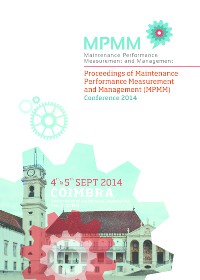Please use this identifier to cite or link to this item:
https://hdl.handle.net/10316.2/33365| Title: | Bottom to top approach for railway KPI generation | Authors: | Villarejo, Roberto Johansson, Carl-Anders Leturiondo, Urko Simon, Victor Galar, Diego |
Keywords: | maximum railway assets;fusion;hierarchy;granularity;aggregation;KPI;performance;DSS | Issue Date: | 2014 | Publisher: | Imprensa da Universidade de Coimbra Faculdade de Ciências e Tecnologia da Universidade de Coimbra, Departamento de Engenharia Mecânica |
Journal: | Colecao:http://hdl.handle.net/10316.2/33309 | Abstract: | Railway maintenance especially on infrastructure produces a vast amount of data. However, having data is not synonymous with having information; rather, data must be processed to extract information. In railway maintenance, the development of KPIs linked to punctuality or capacity can help plan and schedule maintenance, thus aligning the maintenance department with corporate objectives. There is a need for an improved method to analyse railway data to find the relevant KPIs. The system should support maintainers, answering such questions as what maintenance should be done, where and when. The system should equip the user with the knowledge of the infrastructure's condition and configuration, and the traffic situation so maintenance resources can be targeted to only those areas needing work. The amount of information is vast, so it must be hierarchised and aggregated; users must filter out the useless indicators. Data are fused by compiling several individual indicators into a single index; the resulting composite indicators measure multidimensional concepts which cannot be captured by a single index. The paper describes a method of monitoring a complex entity. In this scenario, a plurality of use indices and weighting values are used to create a composite and aggregated use index from a combination of lower level use indices and weighting values. The resulting composite and aggregated indicators can be a decisionmaking tool for asset managers at different hierarchical levels. | URI: | https://hdl.handle.net/10316.2/33365 | DOI: | 10.14195/978-972-8954-42-0_25 | Rights: | open access |
| Appears in Collections: | Proceedings of Maintenance Performance Measurement and Management (MPMM) Conference 2014 |
Files in This Item:
| File | Description | Size | Format | |
|---|---|---|---|---|
| mpmm_artigo25.pdf | 2.62 MB | Adobe PDF |  |
Items in DSpace are protected by copyright, with all rights reserved, unless otherwise indicated.
